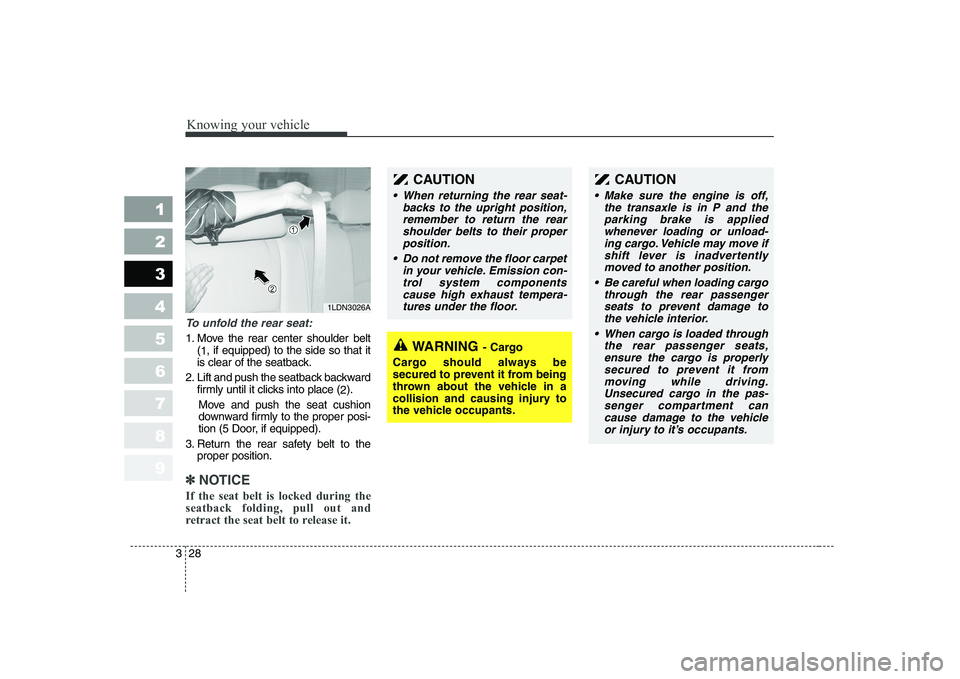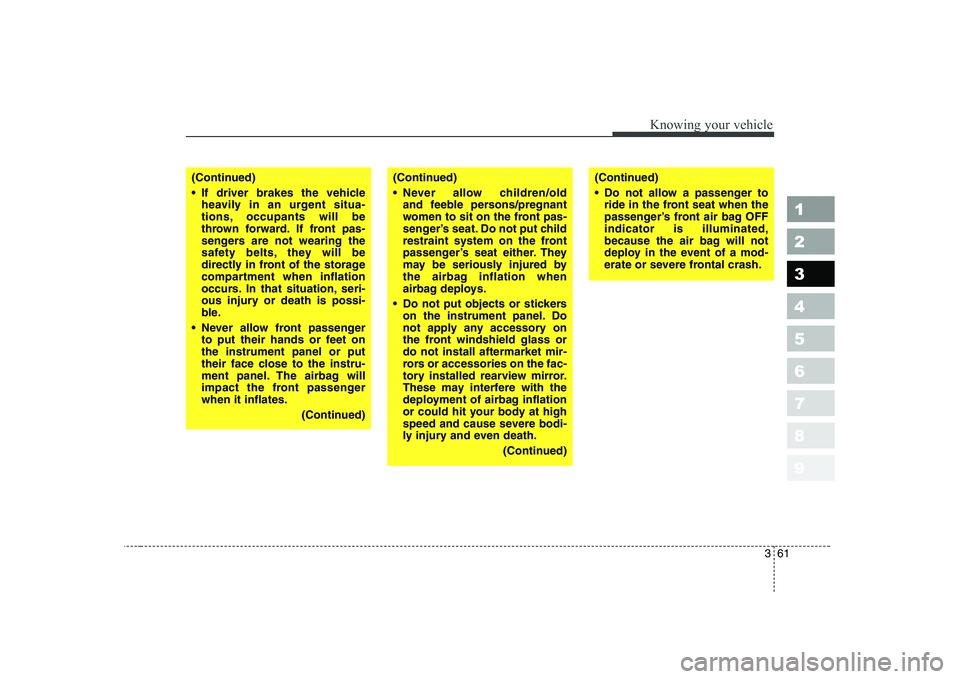Page 6 of 329
13
1 23456789
Introduction
VEHICLE BREAK-IN
PROCESS
No special break-in period is need-
ed. By following a few simple precau-
tions for the first 1,000 km (600
miles) you may add to the perform-
ance, economy and life of your vehi-
cle.
Do not race the engine.
Do not maintain a single speed forlong periods of time, either fast or
slow. Varying engine speed is
needed to properly break-in the
engine.
Avoid hard stops, except in emer- gencies, to allow the brakes to seat
properly.
Avoid full-throttle starts.
Page 8 of 329
Your vehicle at a glance
2
2
1 23456789
INTERIOR OVERVIEW
1. Door lock/unlock button
2. Outside rearview mirror control switch*
3. Power window switches*
4. Master power door lock control*
5. Master power window control lock*
6. Vent controls
7. Instrument cluster
8. Steering wheel
9. Steering wheel tilt*
10. Trunk release button
11. Instrument panel illumination*
12. TCS button*
13. Headlights leveling device*
14. Rear fog light*
15. Hood release lever
16. Brake pedal
17. Accelerator pedal
18. Fuel filler lid release lever
* : if equipped
OLD006002/OLD026018
Page 10 of 329
Your vehicle at a glance
4
2
1 23456789
ENGINE COMPARTMENT
OLD056001
1. Power steering fluid reservoir
2. Engine oil filler cap
3. Brake fluid reservoir
4. Air cleaner
5. Fuse box
6. Negative battery terminal
7. Positive battery terminal
8. Auto transaxle oil dipstick*
9. Radiator cap
10. Engine coolant reservoir
11. Engine oil dipstick
12. Windshield washer fluid reservoir
* : if equipped
Page 17 of 329
37
1 23456789
Knowing your vehicle
Operating door locks from
outside the vehicle
Turn the key toward rear of vehicleto unlock and toward front of vehi-
cle to lock.
Doors can also be locked and unlocked with the transmitter key. Once the doors are unlocked, it
may be opened by pulling the door
handle.
When closing the door, push the door by the hand. Make sure that
doors are closed securely.
If you lock/unlock the front door with a key, all vehicle doors will
lock/unlock automatically. (ifequipped)
To lock a door without the key, push
the inside door lock button (1) or
door lock switch (2, if equipped) to
the “LOCK” position and close thedoor (3).
✽✽NOTICE
Always remove the ignition key, engage the parking brake, close allwindows and lock all doors when
leaving your vehicle unattended.
DOOR LOCKS
OLD026004
LockUnlock
1LDA2005
Page 20 of 329
Knowing your vehicle
10
3
1 23456789
Rear door child safety lock
The child safety lock is provided to
help prevent children from acciden-tally opening the rear doors from
inside the vehicle. The rear door
safety locks should be used whenev-
er children are in the vehicle.
1LDA2008
WARNING
Leaving your vehicle unlocked
can invite theft or possible harm
to you or others from someone
hiding in your vehicle while you
are gone. Always remove the
ignition key, engage the parking
brake, close all windows and
lock all doors when leaving your
vehicle unattended.WARNING - Unattended
children
An enclosed vehicle can
become extremely hot, causing
death or severe injury to unat-
tended children or animals who
cannot escape the vehicle.
Furthermore, children might
operate features of the vehicle
that could injure them, or theycould encounter other harm,
possibly from someone gaining
entry to the vehicle. Never leave
children or animals unattended
in your vehicle.
Page 38 of 329

Knowing your vehicle
28
3
1 23456789
To unfold the rear seat:
1. Move the rear center shoulder belt
(1 , if equipped) to the side so that it
is clear of the seatback.
2. Lift and push the seatback backward firmly until it clicks into place ( 2).
Move and push the seat cushion
downward firmly to the proper posi-
tion (5 Door, if equipped).
3. Return the rear safety belt to the proper position.
✽✽ NOTICE
If the seat belt is locked during the seatback folding, pull out and
retract the seat belt to release it.
CAUTION
When returning the rear seat- backs to the upright position,remember to return the rear shoulder belts to their properposition.
Do not remove the floor carpet in your vehicle. Emission con-trol system components cause high exhaust tempera-tures under the floor.
WARNING - Cargo
Cargo should always be
secured to prevent it from being
thrown about the vehicle in a
collision and causing injury to
the vehicle occupants.
CAUTION
Make sure the engine is off, the transaxle is in P and theparking brake is appliedwhenever loading or unload- ing cargo. Vehicle may move ifshift lever is inadvertentlymoved to another position.
Be careful when loading cargo through the rear passengerseats to prevent damage tothe vehicle interior.
When cargo is loaded through the rear passenger seats,ensure the cargo is properly secured to prevent it frommoving while driving.Unsecured cargo in the pas- senger compartment cancause damage to the vehicleor injury to it’s occupants.
1LDN3026A
Page 71 of 329

361
1 23456789
Knowing your vehicle
(Continued)
If driver brakes the vehicleheavily in an urgent situa-
tions, occupants will be
thrown forward. If front pas-
sengers are not wearing the
safety belts, they will be
directly in front of the storage
compartment when inflation
occurs. In that situation, seri-
ous injury or death is possi-
ble.
Never allow front passenger to put their hands or feet onthe instrument panel or put
their face close to the instru-
ment panel. The airbag will
impact the front passengerwhen it inflates.
(Continued)(Continued)
Never allow children/old and feeble persons/pregnant
women to sit on the front pas-
senger’s seat. Do not put child
restraint system on the front
passenger’s seat either. They
may be seriously injured by
the airbag inflation when
airbag deploys.
Do not put objects or stickers on the instrument panel. Do
not apply any accessory on
the front windshield glass ordo not install aftermarket mir-
rors or accessories on the fac-
tory installed rearview mirror.
These may interfere with the
deployment of airbag inflation
or could hit your body at high
speed and cause severe bodi-
ly injury and even death.
(Continued)(Continued)
Do not allow a passenger toride in the front seat when the
passenger’s front air bag OFFindicator is illuminated,
because the air bag will not
deploy in the event of a mod-
erate or severe frontal crash.
Page 78 of 329
Knowing your vehicle
68
3
1 23456789
In a slant impact or collision, the
force delivered will be relatively
weaker than that of frontal colli-
sion. So, the airbags may not
inflate. At the moment of an accident, driv-
ers brake heavily with reflex. In
such heavy braking, the front por-
tion of the vehicle is lowered by the
force of the braking and the vehicle
can go under a vehicle with a high-
er ground clearance. Airbags maynot inflate in this situation because
impacts may not be delivered or
may be delivered with less intensi-
ty. Airbags may not inflate in rollover
accidents because airbag deploy-
ment would not provide proper pro-
tection to the occupants.
However, side airbags may inflate when the vehicle is rolled over by a
side impact collision, if the vehicleis equipped with side airbags
and/or curtain airbags.
1GHA22701LDA2065OLD026066